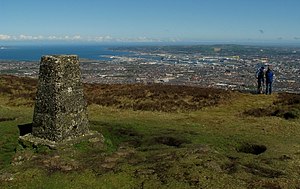Black Mountain, County Antrim
| Black Mountain | |||
| County Antrim | |||
|---|---|---|---|
 Triangulation pillar on Black Mountain | |||
| Range: | Belfast Hills | ||
| Summit: | 1,275 feet J266741 54°35’20"N, 6°1’14"W | ||
Black Mountain is a large hill in County Antrim which overlooks the City of Belfast.
The mountain is one of the most prominent features of the city, towering above most of west Belfast. It reaches a height of 1,275 feet[1] and is composed of basalt with limestone underneath,[2] as is Cavehill further north.
On a clear day there are views of Strangford Lough, the Mourne Mountains and the Sperrins, as well as Wigtownshire across the water and County Donegal the other way.[3]
There have been flint finds in the area, which also contains raths, deserted farms and overgrown paths joining the fields and homesteads and trails scattered over the mountain.[4]
There is a well-known field on the Black Mountain called the 'Hatchet Field' and it is so called because it is in the shape of an old-fashioned hatchet. Also on top of the mountain are police barracks and the Black Mountain transmitting station which is a broadcasting and telecommunications facility.
Ascent
One way to proceed up the mountain is by the 'Mountain Loney,' a path leading up the mountain and across the 'Hatchet Field'. This path is found adjacent to Dermot Hill, a housing estate in west Belfast, and is popular with walkers and tourists.
Conservation and quarrying
For many years people have lobbied for the preservation of the Belfast Hills, hoping to bring an end to many years of quarrying.[5]
The quarry is steep and deeply excavated and the basalt from it is used mostly for road stone.[2]
Outside links
- Divis and the Black Mountain - National Trust
- Virtual tour of Black Mountain - Virtual Visit Northern Ireland
References
- ↑ Walk NI, Divis & Black Mountain
- ↑ 2.0 2.1 Black Mountain Quarry, Belfast, Habitas, Earth Science Conservation Review, National Museums Northern Ireland
- ↑ NITB
- ↑ Belfast Hills
- ↑ NI Assembly